Cosiness and comfort of a country house depend not only on reliable walls and roofs, but also on ...
|
|
Glass designs over the past few years have gained just very popularity ... |
Quite often, during the repair, there is a need to dismantle the old floor ... |
Heating of drains and roofs: with your own hands anti -icing systems
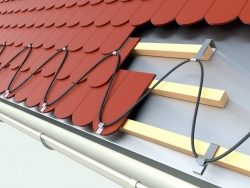
In connection with the climatic features of the terrain, many owners of private houses, whether it is buildings with individual roofs of complex configuration or with simple gable structures, more than once faced the problem of accumulating large masses of snow on them, which, with the onset of intersuzon, led to inexted consequences. Among the most common of them are the destruction of roof materials, frozen water in drain pipes and, as a result, impaired drainage, as well as mass melting of snow rushing a stormy stream into drainage systems, which cannot cope with the uncontrolled stream of water and dirt. Water formed as a result of melting an avalanche -like snow from the roofs of snow rushes into the gutter, where it intensifies the layer by the layer. In addition, the gutters are affected by uneven loads that they experience as a result of the intention of icicles. All this will ultimately disable the drainage system. To eliminate these unpleasant consequences, it is necessary to constantly cleanse the surface of accumulated snow and timely knock icicles in a timely manner, which also create a traumatic situation for people. In order to radically solve the problem, having simplified the care of the storm drain system as much as possible, experts propose to install an anti -icing system based on a heating cable, which can be laid as an independent element along the edge of the roof to prevent its icing. How to understand the characteristics of heating cables and how to correctly install a snowmeling system and anti -disclosure. We will consider further.
Content
- The principle of operation of the anti -icing system of roofs and gutters
- Functions and tasks of the anti -icing system
- The device of the system of anti -icing of drains and roofs
- Features of the heating system of drains and roofs
- Installation of a system of anti -block of drains and roofs with your own hands
- System design plan
- Determination of roof heating zones
- Choosing the type of electric cable
- Selection of a control system and determining the localization of connecting boxes
- Calculation of the length and choice of a cable laying method
- Calculation of the power of the system
- Selection of fasteners and cable laying: Master's advice
The principle of operation of the anti -icing system of roofs and gutters
After the air temperature reaches negative values, crystallization of water begins, which helps to reduce the operational qualities of elements of the drainage system. How does this happen?
- The ice crust formed inside the pipes and gutters creates obstacles when passing the liquid, reducing their maximum throughput;
- Freezing, water expands in volume, which leads to damage to the joints, deformation of the roof elements and even violations of the integrity of the highway;
- Reducing the performance of the construction is a consequence of the formation of ice traffic jams in gutters. They are formed in the presence of extraneous garbage in pipes and gutters and prevent water drainage, which enters the walls and foundation.
To prevent all of the above negative consequences, in the most unfavorable places of the roof (drain pipes, gutters, lends), heating cables that prevent the formation of ice in the course of meltwater movement are installed. Cable power is carried out from an electric network with a voltage of 220-230 V.
The heating process is controlled through a special thermostat that works automatically. Teams to the thermostat come from the sensors installed on the roof. In the event of situations that can cause ice formation, for example, precipitation in a cold period of time or a thaw with dripping snow, the thermostat gives a signal about the need to supply energy, as a result of which the heating of the electric cable begins. This leads to the formation of water, freely flowing through pipes and gutters. Today, programmable thermostats were replaced by the thermostats.
Important! Experts do not recommend reducing the cost of work and mount the heating cable only on the surface of the roof, refusing to heat the gutters. This is due to the fact that snow and ice can often clog the gutters and drainage pipes, which can lead to a violation of their integrity. To prevent this from happening, it is necessary to ensure unhindered convergence of melt water from the roof.
Functions and tasks of the anti -icing system
- Having carried out the installation of the anti -icing of the roof, you will prevent the formation of icicles, the accumulation of snow masses on the roof and, as a result of their fall, which is the cause of traumatic situations;
- Given the above, it can be argued that the installation of the anti -icing of the roof helps to reduce the mechanical load on its structure;
- An increase in the operational period of roofing materials, a system of drains and other structural elements of the roof;
- The installation of a heating system of drains and roofs will eliminate the problem of manual cleaning of the roof of snow and ice masses;
- Organization of regular and timely drainage of melt water from the roof and drains;
- Thanks to the features of the system (the presence of specialized sensors), you will have the opportunity to fully automate the process of heating the roof;
- As the advantage of the system, you can consider the maximum availability and ease of its installation, which even an inexperienced master can independently implement.
Important! If you refuse the installation of a heating system of drains and roofs, motivating it with high costs for electricity, experts are in a hurry to dispel your doubts provided that the cable is laying, the latter will provide reliable heating of the storm gutters, while consuming no more than 200-500 watts, which depends on Roof areas.
The device of the system of anti -icing of drains and roofs
Heating part includes:
- heating cables;
- fasteners.
Distribution and information part is a kit that includes:
- power and information (signal) cables;
- mounting elements;
- distribution boxes in which wire switching.
This part of the system is responsible for the transmission of electric power to the heating part, as well as the transmission of signals from the sensors of control of the roof heating to the control panel.
Control system, which includes the following elements:
- anti -icing thermoregulator;
- start and protective devices, for example, an input three -phase protective machine, a protective shutdown device, protective machines for each phase, etc.;
- signal lamp.
Important! In general, the equipment of the control subsystem is selected taking into account the power of the system of anti -delaying drains and roofs. The heating part, for the installation of which a self -regulating cable was used, can operate automatic control. This is due to its ability to independently regulate power under the influence of temperature and the presence of precipitation.
Features of the heating system of drains and roofs
The design features and the principle of installation of the heating system of drains and roofs depend on the following factors:
- Climatic features of the region;
- View of the roof;
- Type of electric cable.
Particular attention must be paid to the varieties of the roof, which directly determines the design features of the system of anti -icing of drains.
- Warm roof. Due to the fact that in the process of its installation, insulation is not paid to sufficient attention, ice growths are often formed on it, which, due to the design features of the roof, melt even at negative temperatures, after which the water, flowing to the cold edge, freezes. Experts recommend taking this into account and lay on the edge of heating sections in the form of loops, the width of which is from 30 to 50 cm, and the specific power of 200-500 W/sq. m;
- Cold roof, whose heating is characterized by fundamental differences. Due to the fact that they are qualitatively isolated and often differ in the presence of a well-ventilated attic, for their heating, experts recommend that only the installation of the driving anti-icing system, the linear power of which is 20-30 W/sq. m with a gradual increase to 60-70 W/sq. m. As the length of the drain increases.
Installation of a system of anti -block of drains and roofs with your own hands
System design plan
- The correct determination of the zones of heating of the roof, where the electric cable will be laid;
- Selection of a suitable type of electric cable;
- Selection of a control system and determining the localization of connecting boxes;
- Calculation of the length and choice of the method of laying the cable;
- Calculation of the power of the system;
- Selection of fasteners and cable laying;
- Selection of automation for control panel.
Determination of roof heating zones
Roof heating zones Places of the greatest accumulation of snow and ice, where it is necessary to lay an electric cable. To ensure unhindered drainage of melt water, cable laying is carried out in the following areas:
- drainage gutter, their elements and space around them;
- drain pipes throughout;
- water collectors and drainage trays;
- cornices on the roof;
- on the joints of the joints of individual sections of the roof and adjacent walls, in the valleys.
Important! Planning heating of drains should be carried out taking into account the heating of the entire roof, since otherwise the effectiveness of the entire system is reduced.
Important! During the installation of the system, the anti -icing cable is laid in the course of the drainage of melt water. It is important to use only waterproof sections, and their fixation is carried out as reliably as possible. Often, cable tension limiters are installed on top of the drain pipes.
Choosing the type of electric cable
The operation of an electric cable used to heat the gutters and roofs is carried out in technically difficult conditions, moisture, temperature changes, and mechanical loads are affected. In this regard, he must meet the following requirements:
- Be airtight and resistant to atmospheric influences;
- Be indifferent to temperature differences and maintain your initial characteristics even at negative temperatures;
- Have high mechanical strength in order to withstand the effects of a possible snow load without problems;
- Be safe in terms of electrical insulating characteristics.
Important!You can purchase an electric cable in the bays or in the form of ready -made sections, which are fragments of a fixed length cable with a coupling and a wire designed to connect to the network.
The cable supplied in bays is most often used for water -resistant and installation of anti -icing systems on roofs of complex configuration, and therefore, in standard situations, experienced craftsmen advise choosing ready -made sections. They are considered a more convenient option, easy to install.
The functioning of anti -icing systems can be carried out on the basis of warming cables of two types:
- Resistive;
- Self -regulatory.
Let us consider in more detail the characteristics of each group.
Type No. 1. Reset cables
Resistant cables The traditional option, a distinctive feature of which is the same output power along the entire length and the same heat generation. The section is a metal core, an insulating layer, a copper braid and an outer shell. During the installation of anti-icing systems, it is recommended to use resistive cables, the heat emission of which is 15-30 W/m, and the operating temperature is 250 degrees.
Important! One of the main features of the resistive cable is constant resistance and the same heating along the entire length. The degree of heating is determined only by the current strength and does not depend on the external conditions that can be diametrically opposite to different sections of the cable. For example, one of the sections of the cable can be located in a pipe, the other in the open air, and the third is hidden under foliage or snow. In this regard, the optimal functioning of a particular section of the cable requires a different amount of heat, but the resistive cable cannot independently regulate the temperature depending on external conditions. This is the cause of high, but often unproductive energy consumption.
Several varieties of resistive cables are distinguished:
Consistent resistive cables are a variety that is characterized by a fairly simple structure. Its basis is a continuous conductive vein, represented by a copper wire and covered with an insulating layer on top. On top, the wire is covered with a shielding braid that prevents electromagnetic radiation and performs grounding function. The outer layer of the wire is represented by a polymer shell that protects from a short circuit.
Advantages of a consistent resistive cable:
- High flexibility, thanks to which it can be used when installing icing systems for the roof of complex configuration;
- Ease of installation, due to the lack of need to use unnecessary elements;
- Affordable price.
Zonal resistive cables An advanced variety of consecutive cables, the constructive basis of which is two parallelly located veins that conduct current. Around them, a heating wire, screwed in the form of a spiral and characterized by high resistance. Usually nichrome, this spiral through the contact windows in isolation alternately interacts with both conductive cores, forming independent heat generation zones. In case of overheating, only one functional zone will fail, while the rest will continue their work.
Advantages of a resistive zonal cable:
- The presence of independent heating zones, which prevents the prevention of cable overheating;
- High flexibility that allows you to use it to heat roofs with a complex configuration;
- Affordable price.
Type No. 2. Self -regulatory cables
Self -regulating cablesThey differ from their resistive analogue by the presence of a matrix of a semiconductor layer connecting two conductive veins. In addition, on the cut of a self -regulating cable, you can see a photopolymer isolation, an shielding shell represented by a foil or a wire braid, as well as external plastic insulation.
Important! Due to the presence of two insulating layers (internal and external), the self -regulating cable acquires high dielectric strength and resistance to shock loads.
Important! The matrix is \u200b\u200bthe main distinguishing detail of self -regulating cables. It changes its resistance depending on the ambient temperature. For example, with an increase in the temperature of atmospheric air, the resistance of the matrix increases, which helps to reduce the heating of the cable itself. This is the principle of self -regulation, which underlies the work of a self -regulating cable.
Advantages of a self -regulating cable:
- The ability to adjust the degree of heating depending on the ambient temperature;
- Durability due to the lack of risk of overheating and burnout;
- The possibility of cutting into pieces of the required length (up to 20 cm) directly at the installation site;
- Despite the fact that the cost of a self-regulating cable is 2-4 times higher than the cost of a resistive one, in general, this option is more economical due to the economical energy consumption;
- Simplicity of installation;
- Low power consumption from 15 to 20 W/m.
Selection of a control system and determining the localization of connecting boxes
As devices used as a control system, the following can be noted:
- Thermoregulatorsupplies a command to turn on the heating system in a given temperature range from -8 to +3 degrees;
- Thermostat or weather stationIn addition to the temperature, the monitoring the situation with precipitation on the roof and their melting. The basis of the weather station is a moisture sensor and a temperature sensor.
The placement of connecting boxes should be carried out in such a way that free access to them is maintained. Usually they are mounted on a roof near heating elements. Installation under the visor, in the attic and parapets is also possible.
Calculation of the length and choice of a cable laying method
Before proceeding with the installation of the cable, it is necessary to calculate its length and determine the location. Since the sections on which the heating elements are laid, we examined above, we denote how to determine the length of the cable.
To do this, it is necessary to measure the length of all parts of the system, taking into account the quantity and cutting of the drain, as well as the length of the apple. For every 100-150 mm of the gutter, a power of 30-60 W/m is required.
Calculation of the power of the system
When calculating the power of the electric cable, it is necessary to rely on regulatory indicators. If the resistive type for cables, the required power is 18-22 W/m, then for a self-regulating 15-30 W/m. It is important to remember if polymeric materials were used for the manufacture of the drainage system, the cable power should not exceed 17 W/m, which will avoid damage to the drainage system.
Selection of fasteners and cable laying: Master's advice
In the process of installing the heating system, it is necessary to prepare the following elements:
- Thermal cable, the length of which is determined by the total area of \u200b\u200bthe system, the diameters of the elements and the type of cable itself;
- Fasteners For the roof, a reinforcing mesh is used, an anchor plates and self -adhesive tapes for gutters. The minimum distance between the fasteners should be at least 30 cm. If you use steel plates, pay attention to their surface it should be galvanized, which will prevent premature rust.
What to pay special attention to?
- Make sure that the heating part did not bend in the section, did not experience a break and stretching and other mechanical influences;
- In accordance with SNiP, the heating section needs grounding. If you intend to lay the cable with boots, then the diameter of the drain pipe should be at least 70 mm, which is due to the minimum radius of the cable bend;
- Make sure that the integrity of the cable insulation is not violated during the installation of the heating sections. This is due to the hygroscopicity of the matrix, due to which heating areas will absorb moisture and will soon fail.

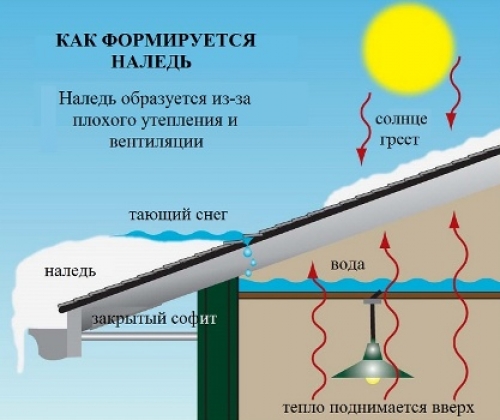
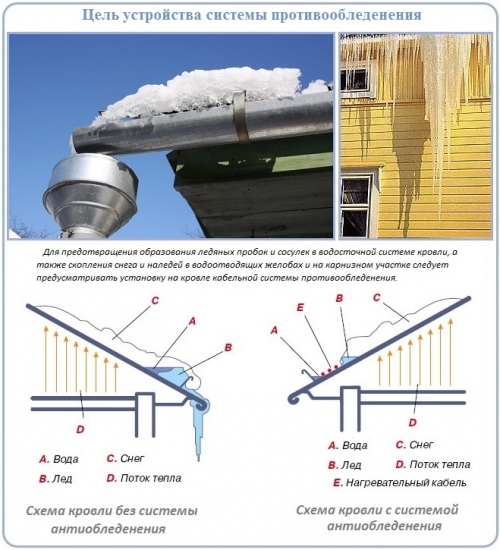
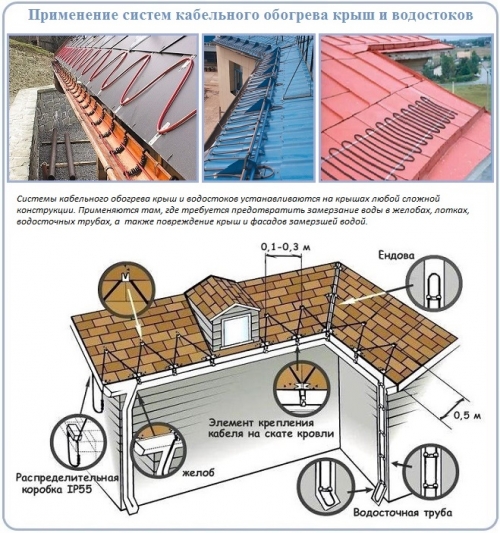
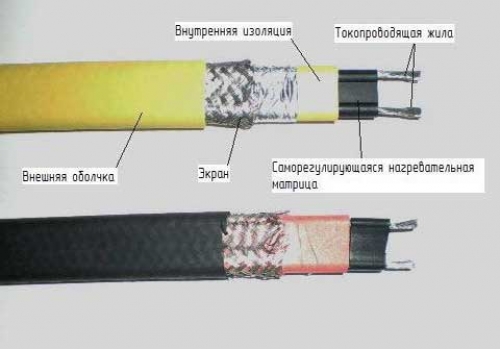
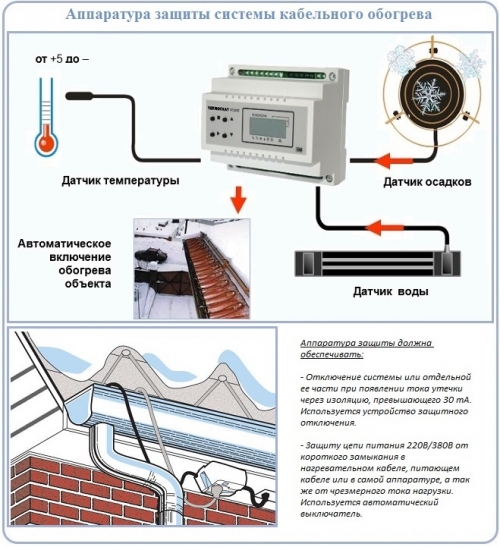
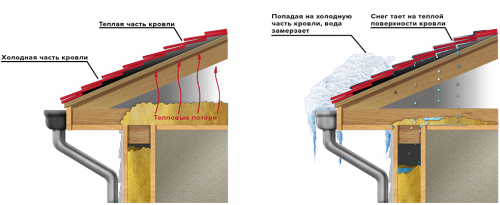
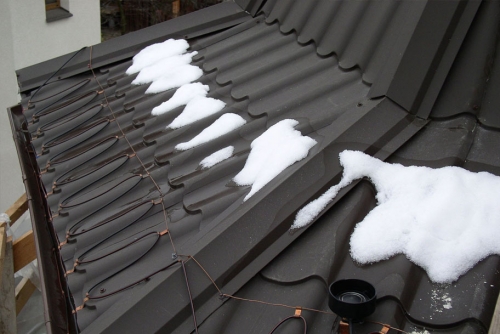
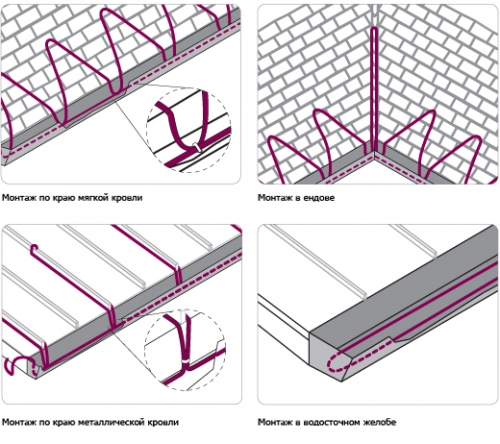
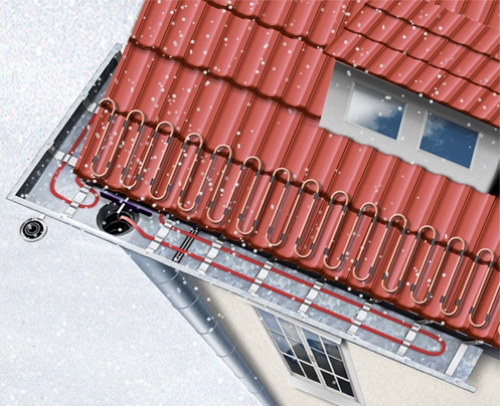
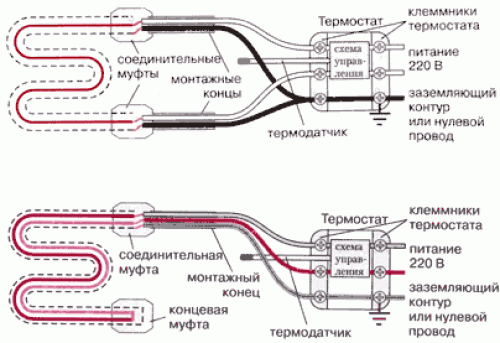
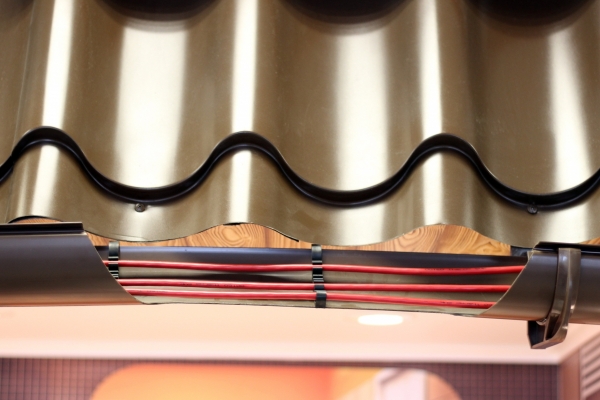
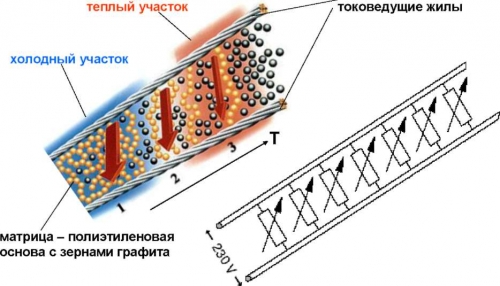
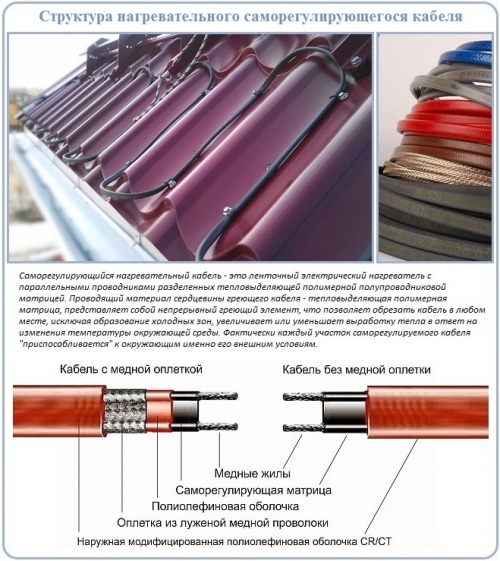
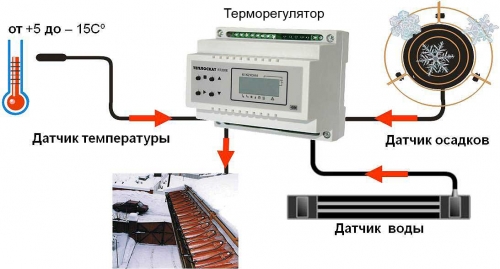
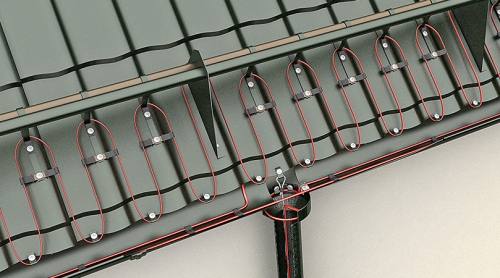
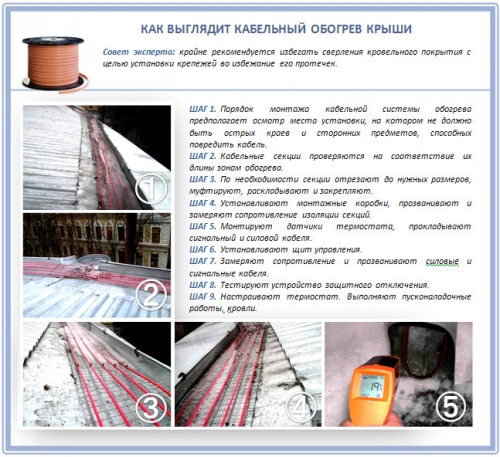
Many save on heating
Many save on heating of the roof and drains, but this can turn into corruption of the roof and the drainage system. I don’t want to take risks, therefore, immediately, when building a house, I installed a cable electric heating system Freezstop http: //strport.ru/stroitelstvo-domov/obogGrev-vodostokov-i-krovli-sistemy .... Over the past winter, the system showed itself well, Therefore, I can safely recommend it.